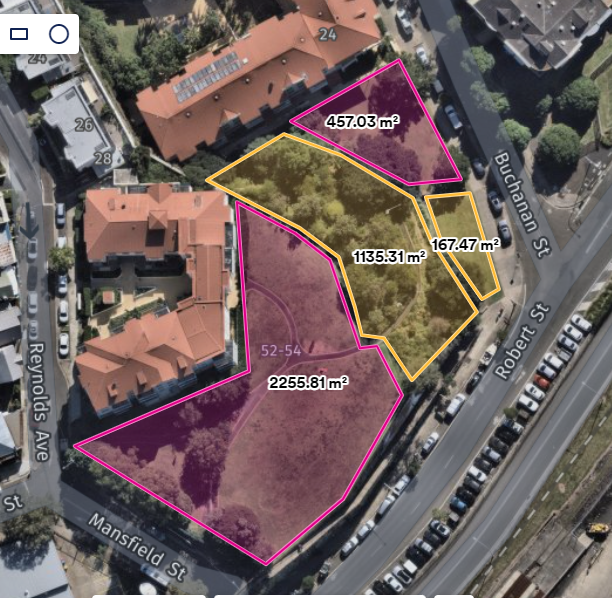Waterdale Park Natural Area extension
Project details
Address
Waterdale Park, Buchanan Street, Rozelle
Description
The Waterdale Park Natural Area extension works towards Council’s commitments in the Our Inner West 2036 Community Strategic Plan to “An increasing and resilient network of green corridors provide habitat for plants and animals”. The extension will establish Waterdale Park as a gateway to the proposed White Bay Eco-corridor where Council is trying to offset the loss of trees and habitat from recent major Infrastructure projects.
Works will include preparation for planting (spraying herbicide and mulching), planting with shrubs under 6m, grasses and groundcovers, and installation of temporary fencing to protect plants while they are establishing.
Read more about Natural Areas at this page.
Progress
Planning stage
Expected completion date
July 2023
Budget
$20,000
Project contact
Luke Murtas on urbanecology@innerwest.nsw.gov.au
Proposed White Bay Ecological Corridor
Council has received community interest in establishing a connected ecological corridor along the northern shore of White Bay to improve habitat for local animals. We are investigating opportunities to improve ecological outcomes and connectivity in parks, verges and private property along the proposed corridor.
Questions and answers
Why do we need Natural Areas and why is it important in the Inner West?
As our population grows and urban development becomes more dense and compacted the importance of restoring and conserving our natural areas becomes more important for all. The clean air which we all breathe, along with clean drinking water, soil and food production rely on biodiversity. Natural areas are important spaces in the inner city as they provide natural noise barriers, they can assist in reducing pollution as well reduce the impacts of climate events such as flooding and heat impacts. Importantly these areas also provide valuable habitat for native animals and insects.
The creation and ongoing management of natural areas provide for a range of active and passive recreation opportunities and importantly they assist in conserving our natural heritage and creating habitat for local wildlife. The value of these areas is reflected in the community support shown through the volunteer Bushcare programs and community involvement in natural area management.
Natural Areas are challenging assets to manage. Often there is a conflict between managing the natural values of natural areas as well as providing for community use of these areas. Council undertakes risk assessments with all of its natural area sites and is committed to ensuring that the community is consulted on landscape changes where these are made within the Inner West Council parkland network.
What is involved in restoring or creating a Natural Area?
Natural Area restoration is the process of minimising disturbances and undertaking rehabilitation actions on parkland so that it has an opportunity to return to its natural state. There are a number of different techniques that are used by Council staff and contractors to achieve natural area restoration including:
- Removal of invasive plants in overgrown areas which then allows native species a chance to successfully grow from any remaining seeds stored in the soil that were being suppressed by the weedy growth. Sometimes, a site is so disturbed there are no native seeds left in the soil as no remnant soil remains.
- Reconstructive restorative on-ground actions include planting of native, provenance plant species and installation of habitat structures like logs and rocks for small animals. This practise is the most common practise engaged within the Inner West.
Loss of green space
The creation and restoration of natural plant areas does not imply that there will be a loss of green space. The green space is still present, but it is undergoing a new use which is focussed on habitat value improvement. The Park setting as a whole will have better opportunities for connection to nature as well as support other forms of recreation including birdwatching and plant education and recognition.
This map shows that the extension of the Natural Area at Waterdale Reserve (yellow areas) is well balanced with the turf lawn areas (pink areas):

The assertion that the current Natural Area is not well maintained is false. There are very few if any weeds and the area is maintained by contractors to a very high standard.
Fox concerns
Foxes are found all over the Sydney metropolitan area and they use a wide variety of habitats. Please report foxes spotted in your neighbourhood on Foxscan to help build a better picture of foxes in Inner West Council area.
Rats/water rats
Water rats also known by their indigenous name Rakali, are protected native animals, not vermin. Pest species rats are not attracted to Natural Areas, they usually come for food in bins behind cafes or shops or residential areas.
Risk assessment
One of the greatest risks to humanity is the possibility of the collapse of biodiversity. Extensions to Natural Areas like Waterdale Reserve are part of Council's response to this risk.